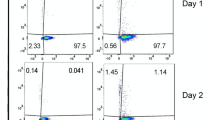Abstract
This study describes the fine structure and reproduction of tachyzoites of Hammondia heydorni (isolate Berlin 1996) after in vitro cultivation of stages isolated from serial passages between dogs and various intermediate hosts such as mice, rats, guinea pigs, jirds, knock-out mice, goats and sheep. The tachyzoites are identical with respect to their ultrastructural features to the corresponding stages of the NC-1-strain of Neospora caninum. This fact conforms with other already published data and underlines our opinion that the recently redescribed N. caninum Dubey et al. 2002 is a synonym of the previously described H. heydorni (Tadros and Laarman 1976) Dubey 1977.





Similar content being viewed by others
References
Blagburn BL, Lindsay DS, Swango LJ, Pidgeon GL, Braund KG (1988) Further characterization of the biology of Hammondi heydorni. Vet Parasitol 27:193–198
Darius A, Mehlhorn H (2003) Light and electron microscopic studies on effect of Toltrazuril and Ponazuril on developmental stages of the NC-1 strain of Neospora caninum (syn. Hammondia heydorni) in tissue cultures and in immuno-suppressed mice. Parasitol Res (in press)
Dubey JP (1977) Toxoplasma, Hammondia, Besnoitia, Sarcocystis and other tissue-cyst forming coccidia of man and animals. In: Kreier JP (ed) Parasitic protozoa, vol 3. Academic Press, New York, pp 171–175
Dubey JP (1993) Toxoplasma, Neospora, Sarcocystis, and other tissue cyst-forming coccidia of humans and animals. In: Kreier JP (ed) Parasitic protozoa, vol 6. Academic Press, San Diego, pp 75–78
Dubey JP, Fayer RC (1976) Development of Isospora bigemina in dogs and other mammals. Parasitology 73:371–380
Dubey JP, Barr BC, Barta JR, et al (2002a) Redescription of Neospora caninum and its differentiation from related coccidia. Int J Parasitol 32:929–946
Dubey JP, Hill DE, Lindsay DS, Jenkins Mc, Uggla A, Speer CA (2002b) Neospora caninum and Hammondia heydorni are separate species. Trends Parasitol 18:66–69
Ellis JT, Morrison DA, Liddell S, Jenkins MC, Mohammed OB, Ryce C, Dubey JP (1999) The genus Hammondia is paraphyletic. Parasitology 118:357–362
Heydorn AO (1973) Zum Lebenszyklus der kleinen Form von Isospora bigemina des Hundes. I. Rind und Hund als mögliche Zwischenwirte. Berl Muench Tierärztl Wochenschr 86:323–329
Heydorn AO (1985) The development of Sarcocystis arieticanis. Berl Muench Tierärztl Wochenschr 98:231–241
Heydorn AO, Mehlhorn H (2002) Neospora caninum is an invalid species name: an evaluation of facts and statements. Parasitol Res 88:175–184
Heydorn AO, Unterholzner J (1983) Zur Entwicklung von Sarcocystis hircicanis n. sp. Berl Muench Tierärztl Wochenschr 96:275–282
Heydorn AO, Gestrich R, Ipcznski V (1975) Zum Lebenszyklus der kleinen Form von Isospora bigemina des Hundes. II. Entwicklungsstadien im Darm des Hundes. Berl Muench Tierärztl Wochenschr 88:449–453
Levine ND, Ivens V (1965) Isospora species in the dog. J Parasitol 51:659–864
Lindsay DS, Upton SJ, Dubey JP (1999) The Neospora caninum oocyst. Proceedings of the 44th American Association for Veterinary Parasitologists meeting, New Orleans. AAVP Press, New Orleans, p 33
McAllister MM, Dubey JP, Lindsay DS, Jolly WR, Wills RA, McGuire AM (1998) Dogs are definitive hosts of Neospora caninum. Int J Parasitol 28:1473–1478
Mehlhorn H, Heydorn AO (2000) Neospora caninum: is it really different from Hammondia heydorni? Parasitol Res 86:169–178
Müller N, Sager H, Hemphill A, Mehlhorn H, Heydorn AO, Gottstein B (2001) Comparitive molecular infestigation of Nc5-PCR amplicons from Neospora caninum NC-1 and Hammondia heydorni-Berlin-1996. Parasitol Res 87:883–885
Reynolds ES (1963) The use of lead citrate at high pH as an electron opaque stain in electron microscopy. J Cell Biol 17:208–12
Schares G, Heydorn AO, Cüppers A, Conraths FJ, Mehlhorn H (2001a) Hammondia heydorni-like oocysts shed by a naturally infected dog and Neospora caninum NC-1 cannot be distinguished. Parasitol Res 87:808–816
Schares G, Heydorn AO, Cüppers A, Conraths FJ, Mehlhorn H (2001b) Cyclic-transmission of Neospora caninum: serological findings in oocyst stedding dogs. Parasitol Res 87:873–877
Schares G, Heydorn AO, Cüppers A, Mehlhorn H, Geuer L, Peters M, Conraths FJ (2002) In contrast to dogs, red foxes (Vulpes vulpes) did not shed Neospora caninum upon feeding of intermediate host tissues. Parasitol Res 88:44–52
Speer CA, Dubey JP (1989a) Ultrastructure of tachyzoites, bradyzoites, and tissue cysts of Neospora caninum. J Parasitol 36:458–463
Speer CA, Dubey JP (1989b) Ultrastructure of sporozoites and zoites of Hammondia heydorni. J Parasitol 36:488–493
Speer CA, Dubey JP, Blixt JA, Blagburn BL (1988) Development of Hammondia heydorni in cultured bovine and ovine cells. J Parasitol 35:352–356
Speer CA, Dubey JP, McAllister MM, Blixt JA (1999) Comparative ultrastructure of trachyzoites, bradyzoites, and tissue cysts of Neospora caninum and Toxoplasma gondii. Int J Parasitol 29:1509–1519
Spurr AR (1969) A low viscosity epoxy resin embedding medium for electron-microscopy. J Ultrastruct Res 26:31–43
Tadros W, Laarman JJ (1976) Sarcocystis and related coccidian parasites: a brief general review, together with a discussion on some biological aspects of their life cycles and a new proposal for their classification. Acta Leiden 44:1–107
Acknowledgements
We are grateful to the following colleagues and technicians: Dr. Riebe (Institute of Infectiology, Federal Research Centre for Virus Diseases of Animals, Insel Riems, Germany) for generously providing the tissue cell-lines to Dr. Schares. Dr. Schares (Department of Epidemiologic Diagnostics, Federal Research Centre for Virus Diseases of Animals, Wusterhausen) for isolating the tachyzoites from our infected animals, their cultivation in Dr. Riebe's cells and for providing infected cells for our TEM–examination. Dr. W. Peters (now: Regierungspräsidium Arnsberg, Germany) for providing Fig. 5 from his TEM-investigations done parallel to ours.
Author information
Authors and Affiliations
Corresponding author
Rights and permissions
About this article
Cite this article
Mehlhorn, H., Heydorn, A.O. Electron microscopic study of in vitro cultures of Hammondia heydorni (Berlin 1996) tachyzoites after passages through dogs, mice, rats, guinea pigs and jirds. Parasitol Res 90, 512–520 (2003). https://doi.org/10.1007/s00436-003-0889-3
Received:
Accepted:
Published:
Issue Date:
DOI: https://doi.org/10.1007/s00436-003-0889-3




